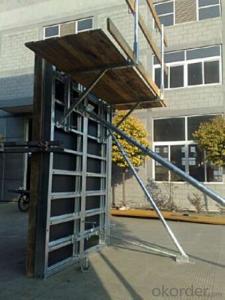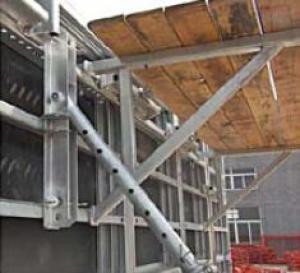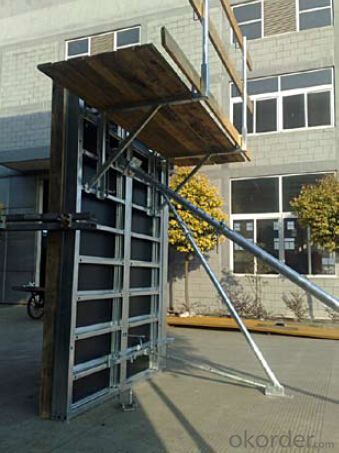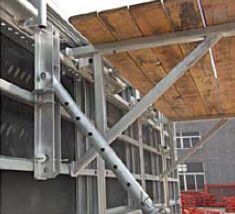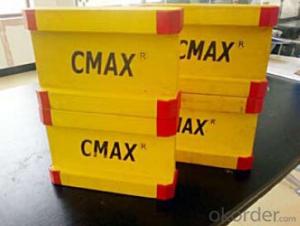Steel-Frame Working Platformfor Formwork and Scaffolding system
- Loading Port:
- Tianjin
- Payment Terms:
- TT OR LC
- Min Order Qty:
- 50 m²
- Supply Capability:
- 1000 m²/month
OKorder Service Pledge
OKorder Financial Service
You Might Also Like
Steel-frame Formwork SF-140
Characteristics:
◆ Few parts for fast forming.
◆ Max. Concrete pressure: 80KN/m2.
◆ Hot-dip galvanized steel frame.
◆ The thickness of plywood is 18mm & the panel is 14cm.
◆ Compatibility with Hunnebeck Manto system due to similar edge profile.
System Details & Application:
◆ Neat joint and fast assembling with aligning panel clamp.
◆ Flexible panel arrangement and height extension.
◆ The selection of panels.
◆ Kinds of panel connectors.
◆ Corner clamp application.
◆ Length adjustment application.
◆ Height adjustment & aligning strut.
◆ Walkway bracket & platform.
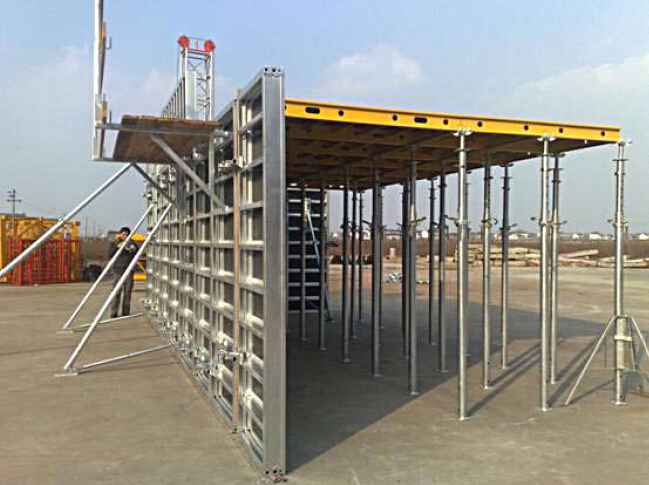
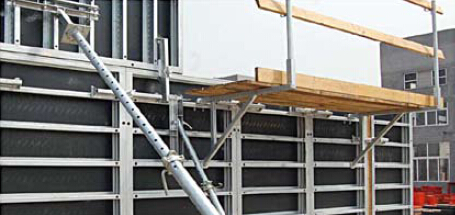
- Q: What are the different types of steel formwork systems available?
- There are several different types of steel formwork systems available, including traditional steel formwork, modular steel formwork, and tunnel formwork. Traditional steel formwork consists of steel panels and supports that are assembled on-site to create the desired formwork structure. Modular steel formwork, on the other hand, is pre-assembled in a factory and can be easily transported and installed. Lastly, tunnel formwork is a specialized type of steel formwork used for constructing tunnels, where the formwork is moved forward as the tunnel progresses.
- Q: How does steel formwork contribute to the overall durability of the structure?
- Steel formwork contributes to the overall durability of a structure in several ways. Firstly, steel is a strong and rigid material that provides excellent support and stability during the concrete pouring process. This ensures that the structure maintains its shape and form accurately, minimizing any potential deformations or cracks. Additionally, steel formwork is highly resistant to corrosion, which helps protect the concrete from moisture and other environmental factors that can weaken its integrity over time. Furthermore, steel formwork can be easily reused multiple times, reducing material waste and increasing cost-effectiveness. Overall, the use of steel formwork enhances the structural strength and longevity of the building, ensuring its durability for years to come.
- Q: How does steel formwork contribute to better concrete compaction?
- There are several ways in which steel formwork contributes to improved concrete compaction. Firstly, it offers a rigid structure that securely holds the concrete in place while it is being poured and cured. This rigidity prevents any movement or shifting of the concrete, enabling a more even distribution of the concrete mix and reducing the likelihood of segregation or honeycombing. Furthermore, steel formwork often incorporates various features like tie rods and walers, which allow for proper alignment and tightening of the formwork. This ensures that the formwork remains stable and tight, minimizing any gaps or voids that could result in inadequate compaction. In addition, steel formwork is typically designed with smooth surfaces, which facilitates the creation of a smooth and uniform finish on the concrete. This smoothness enhances compaction as the concrete can flow more easily and evenly into all parts of the formwork. Moreover, steel formwork is highly durable and capable of withstanding the pressure exerted by the concrete during the pouring and compaction process. This durability ensures that the formwork remains intact and does not deform or collapse, enabling proper compaction of the concrete. Overall, steel formwork provides a strong and stable structure that allows for enhanced control of the concrete pouring and compaction process. It helps eliminate any potential complications that may arise during compaction, resulting in a concrete structure of higher quality and greater density.
- Q: How does steel formwork handle concrete shrinkage and cracking?
- Steel formwork is a versatile and durable option for handling concrete shrinkage and cracking. It is designed to provide support and stability during the pouring and curing process, and its rigid structure helps to minimize the effects of shrinkage and cracking. One of the key advantages of using steel formwork is its ability to withstand the pressure exerted by the concrete as it shrinks. Steel is a strong and resilient material that can resist the forces generated by the drying and hardening of the concrete. This helps to prevent the formwork from deforming or collapsing under the weight of the shrinking concrete, ensuring that the structure remains intact. In addition, steel formwork is often equipped with expansion joints or other flexible elements that can accommodate the movement caused by shrinkage and cracking. These joints allow the formwork to expand and contract with the concrete, reducing the stress on the structure and minimizing the risk of cracks forming. Furthermore, steel formwork can be easily reinforced or supplemented with additional support elements, such as braces or tie rods, to further enhance its ability to handle concrete shrinkage and cracking. These reinforcements help to distribute the forces exerted by the shrinking concrete more evenly across the formwork, reducing the likelihood of localized cracking or structural failure. Overall, steel formwork provides a robust and reliable solution for managing concrete shrinkage and cracking. Its strength, flexibility, and ability to be reinforced make it an ideal choice for construction projects where minimizing the impact of these issues is crucial.
- Q: Can steel formwork be used for both interior and exterior concrete finishes?
- Yes, steel formwork can be used for both interior and exterior concrete finishes. Steel formwork is known for its strength and durability, making it suitable for a variety of applications. Whether it is for interior walls, columns, or exterior slabs, steel formwork provides a smooth and consistent surface for the concrete to be poured into. Additionally, steel formwork can be easily customized and adjusted to meet specific project requirements, making it a versatile choice for both interior and exterior concrete finishes.
- Q: How does steel formwork handle concrete consolidation and compaction?
- Steel formwork excels in its ability to handle concrete consolidation and compaction. Its rigidity and strength create a stable and secure structure that effectively contains and supports the concrete throughout the pouring and setting process. Primarily, steel formwork is designed to be sturdy and resistant to deformation, maintaining its shape and structure even under the pressure exerted by fresh concrete. This stability prevents any misalignment or distortion, resulting in a uniform and even placement of the concrete. Furthermore, steel formwork can easily be reinforced with additional supports and bracing to enhance its strength and rigidity. This reinforcement prevents any movement or displacement of the formwork during the consolidation and compaction stages, effectively containing the concrete within and allowing for proper consolidation. Additionally, steel formwork provides a smooth surface for the concrete, facilitating the consolidation and compaction process. The smoothness reduces friction between the formwork and the concrete, making compaction easier and more efficient. This results in a denser and more homogeneous concrete, improving its strength and durability. Moreover, the precise dimensions and tight joints of steel formwork ensure proper confinement and compaction of the concrete. The accuracy and tightness of the formwork prevent any leaks or seepages of the cement paste, maintaining the desired shape and integrity of the concrete. This is particularly important in construction projects that require precision and structural integrity. In conclusion, steel formwork is highly effective for concrete consolidation and compaction, thanks to its robustness, stability, smooth surface, and precise dimensions. Its ability to contain and support the concrete during pouring and setting ensures a uniform and properly compacted structure, contributing to the strength and durability of the final construction product.
- Q: What are the weight limitations of steel formwork?
- The weight limitations of steel formwork depend on various factors such as the specific type of steel used, the design and structure of the formwork, and the load-bearing capacity of the supporting structure. However, in general, steel formwork can typically handle heavy loads ranging from several hundred kilograms to several tonnes per square meter. It is important to consult the manufacturer's specifications and engineering professionals to determine the exact weight limitations for a specific steel formwork system.
- Q: Can steel formwork be used for both straight and curved concrete walls?
- Yes, steel formwork can be used for both straight and curved concrete walls. Steel formwork is flexible and can be easily shaped to create curved or irregular shapes, making it suitable for constructing both straight and curved concrete walls.
- Q: Are there any specific considerations for using steel formwork in seismic zones?
- Using steel formwork in seismic zones comes with several specific considerations. Firstly, steel formwork offers superior strength and stiffness compared to other materials like wood or aluminum. This is crucial in seismic zones where the structure must withstand the lateral forces caused by earthquakes. The high strength of steel formwork helps prevent deformation or failure during seismic events. Secondly, steel formwork is known for its durability and reusability, which is especially important in seismic zones with frequent earthquakes. The formwork needs to withstand multiple cycles of loading and unloading, and steel formwork's robustness and ability to handle repeated use make it suitable for seismic zones where replacing formwork regularly may not be feasible. Another consideration is the design of the steel formwork panels. In seismic zones, it's important to ensure the panels have sufficient stiffness to resist lateral forces. This can be achieved by using thicker steel plates or adding stiffening elements to the formwork structure. Additionally, the joints between formwork panels should be well-designed and properly reinforced to resist the dynamic forces brought on by earthquakes. Furthermore, the connection between the steel formwork and the supporting structure must be carefully designed. In seismic zones, a strong and rigid connection is crucial to prevent the formwork from detaching or collapsing during an earthquake. Adequate reinforcement, proper anchorage, and well-designed joint details are essential for the stability of the formwork system under seismic loads. Lastly, the construction sequence and timing of formwork removal should be considered in seismic zones. The formwork should provide sufficient lateral support to the concrete during the curing process, as premature removal can compromise the structural integrity. Careful planning of formwork removal is necessary to avoid sudden changes in load distribution that could impact the seismic performance of the structure. In conclusion, using steel formwork in seismic zones requires considerations such as strength, durability, design, connection, and construction sequence to ensure the safety and stability of the formwork system and the overall structure during seismic events.
- Q: Types of building templates? What is the clear water template
- 2 steel template: in addition to the combination of steel templates, has developed a wide steel template, all steel large formwork, light large steel mold, steel frame, such as 63 steel template. The high cost of steel mold, in addition to large projects such as bridges or other buildings, nuclear power plants, reservoirs and other construction sites, has been replaced by building wooden template.
Send your message to us
Steel-Frame Working Platformfor Formwork and Scaffolding system
- Loading Port:
- Tianjin
- Payment Terms:
- TT OR LC
- Min Order Qty:
- 50 m²
- Supply Capability:
- 1000 m²/month
OKorder Service Pledge
OKorder Financial Service
Similar products
Hot products
Hot Searches
Related keywords
